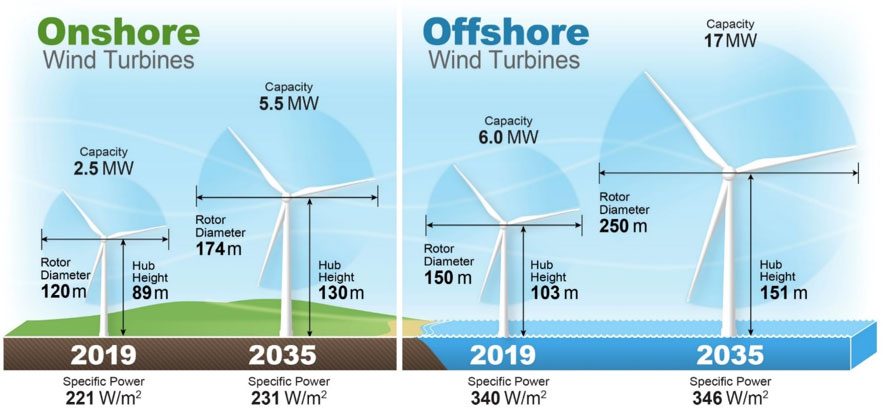Experts’ Predictions for Future Wind Energy Costs Drop Significantly
Berkeley Lab-led study shows expected cost declines of 17%-35% by 2035 and 37%-49% by 2050
Technology and commercial advancements are expected to continue to drive down the cost of wind energy, according to a survey led by Lawrence Berkeley National Laboratory (Berkeley Lab) of the world’s foremost wind power experts. Experts anticipate cost reductions of 17%-35% by 2035 and 37%-49% by 2050, driven by bigger and more efficient turbines, lower capital and operating costs, and other advancements. The findings are described in an article in the journal Nature Energy.
The study summarizes a global survey of 140 wind experts on three wind applications – onshore (land-based) wind, fixed-bottom offshore wind, and floating offshore wind. The anticipated future costs for all three types of wind energy are half what experts predicted in a similar Berkeley Lab study in 2015. The study also uncovered insights on the possible magnitude of and drivers for cost reductions, anticipated technology trends, and grid-system value-enhancement measures.
“Wind has experienced accelerated cost reductions in recent years, both onshore and offshore, making previous cost forecasts obsolete. The energy sector needs a current assessment,” said Ryan Wiser, senior scientist at Berkeley Lab. “Our ‘expert elicitation’ survey complements other methods for evaluating cost-reduction potential by shedding light on how cost reductions might be realized and by clarifying the important uncertainties in these estimates.”
President Biden signed an Executive Order in January aiming to maximize offshore wind potential and has identified wind power as a key component of the nation’s renewed efforts to combat climate change. Renewable energy sources such as wind and solar will play an important role in efforts to reach net zero carbon emissions by mid-century.
Significant opportunities for, but uncertainty in, cost reductions
Under a “best guess” (or median) scenario, experts anticipate 17%-35% reductions in the levelized cost of energy by 2035 and 37%-49% reductions by 2050 across the three wind applications studied, relative to 2019 baseline values. Levelized costs reflect the average cost of energy per unit of electricity output over the lifetime of an electricity plant and are useful for evaluating technology progress. There are greater absolute reductions (and more uncertainty) in the levelized cost of energy for offshore wind compared with onshore wind, and a narrowing gap between fixed-bottom and floating offshore wind.

Notwithstanding the maturation of both onshore and offshore wind technology, there is substantial room for continued improvement, and costs could be even lower: experts predict a 10% chance that reductions will be 38%-53% by 2035 and 54%-64% by 2050. At the same time, there is uncertainty in these projections, illustrated by the range in expert views and by the “high cost” scenario in which cost reductions are relatively modest.
Multiple drivers for cost reduction: larger turbines are on the horizon
There are five key factors that impact the levelized cost of energy: upfront capital cost, ongoing operating costs, capacity factor, project design life, and cost of financing. Experts anticipate continued improvements across all dimensions, with the relative contribution varying by wind application. “Forecasts that consider only improvements in capital cost will, at best, capture about 45% of the cost reduction opportunity,” noted study co-author Joe Rand, also of Berkeley Lab.
A key driver in these improvements is turbine size, according to experts. For onshore wind, growth is expected not only in generator ratings (to 5.5 megawatts [MW] on average in 2035, up from 2.5 MW in 2019) but also in two other factors that increase capacity – rotor diameters and hub heights. Offshore wind turbines are expected to get even bigger, to 17 MW on average in 2035, up from 6 MW in 2019. Floating offshore wind is anticipated to gain market share, growing from its current pre-commercial state and accounting for up to 25% of new offshore wind projects by 2035.
Implications for the future of wind energy
Wind energy has grown rapidly, but its long-term contribution to energy supply depends, in part, on future costs and value. The new study finds that cost reductions have accelerated in recent years: faster than previously predicted by most forecasters, and faster than historical rates of decline. The experts surveyed anticipate future reductions and growing use of value-enhancement measures, both for onshore wind and offshore wind.
“All else being equal, these trends will enable wind to play a larger role in global energy supply than previously thought while facilitating energy-sector decarbonization,” concluded co-author Joachim Seel, also with Berkeley Lab. “Analysts, investors, planners, and policymakers should avoid outdated assumptions and forecasts.” At the same time, as documented in the study, uncertainties in the magnitude of future cost reduction are significant, illustrating the importance of embedding uncertainty considerations in modeling and in policy, planning, investment, and research decisions.
The study was led by Berkeley Lab, and included contributions from the National Renewable Energy Laboratory, the U.S. Department of Energy, the University of Massachusetts, and scores of other advisors. The survey was conducted under the auspices of the IEA Wind Technology Collaboration Programme. Berkeley Lab’s contributions were funded by the U.S. Department of Energy’s Office of Energy Efficiency and Renewable Energy.
- A PowerPoint-style briefing that summarizes the survey findings in greater depth and a two-page factsheet can be downloaded here.
- A free webinar summarizing the findings of the survey will be held on April 29, 2021, from 10:00 am to 11:00 am Pacific Time (1:00 pm-2:00 pm Eastern Time, 19:00-20:00 Central European Time). To receive log-in instructions for the webinar, register here.
Source
Lawrence Berkeley National Laboratory, Kalifornien, USA | Julie Chao 2021 | et al., Nature Energy, doi: 10.1038/s41560-021-00810-z









